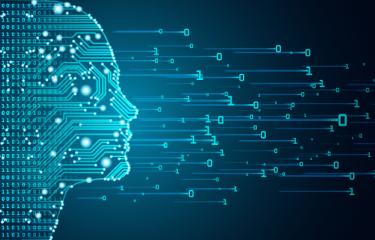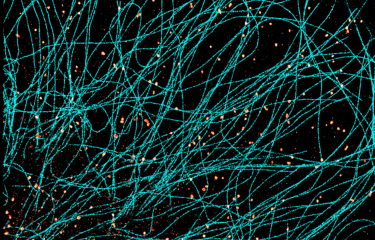Christophe Zimmer, Head of the Imaging and Modeling Unit at the Institut Pasteur, looks at artificial neural networks, algorithms with learning ability (deep learning), which fuel the renewed interest in artificial intelligence.

Artificial intelligence will play a key role in personalized medicine.
Christophe ZimmerHead of the Imaging and Modeling Unit at the Institut Pasteur
What are artificial neuronal networks?
They are algorithms containing a large number of computational units, known as "neurons", which are used to learn complex relationships between very different types of digital data, such as text, sound or images. All these data can be represented as tables of numbers, and these numbers are fed as inputs to a first layer of neurons. Each of these neurons performs a fairly simple calculation and produces a new digital value as output. This value, along with those computed by other neurons, is sent to neurons of another layer, which then send the outcome of their calculation to another layer, and so on, until the last layer, which represents the final output (also often called “prediction”). This propagation of information between neurons remotely resembles what occurs in the brain, and the combination of a large number of basic calculations can lead to very complex mathematical transformations. Crucially, the calculation performed by each neuron depends not only on the input data, but also on a large number of parameters, also called "weights". These weights are not specified a priori, but determined gradually by analyzing training data, hence the notion of "learning".
Can you give us an example of deep learning?
A textbook example is the task of automatically classifying pictures of cats and dogs. Human beings can almost instantly tell the difference between a picture of a cat and that of a dog because evolution has provided us with a very powerful visual recognition system (a network of billions of biological neurons). But it is practically impossible to manually program an algorithm that can distinguish between these two categories of images from scratch.
In deep learning, we start with a set of photographs of dogs and cats that have already been seen and labeled by humans (for example with a 0 for dogs and 1 for cats). The images and their labels are the training data. The neural network takes each image as input and outputs a value between 0 and 1, which can be interpreted as the probability that the image shows a cat or a dog. At first, the values calculated by the network are random, as if the algorithm was blind. But since we already know the correct answers, we can accurately assess the errors made by the algorithm. Thanks to an algorithm known as “backpropagation”, the weights of the neurons are gradually adjusted to reduce these errors. At the end of this process, the network predicts values close to 0 for dogs and 1 for cats.
Of course, this exercise would be pointless if it was limited to training data. But, if all goes well, the neural network also acquires the ability to generalize, i.e. it becomes capable of distinguishing between cats and dogs in completely new images. And in many cases it can do so as accurately as a human - or better.
Why this recent surge in deep learning and, more generally, in artificial intelligence?
Artificial intelligence is a generic term that refers to many different approaches besides deep learning, but the breakthroughs achieved by deep learning are the main driver behind the current resurgence of interest in AI.
Deep learning is a recent name for algorithms using artificial neural networks with many layers of neurons (deep nets). These algorithms have existed for several decades, but at the time, neural networks only worked well on relatively simple data, mainly because training data and computing power were limited. Today, thanks to increased digitalization and the Internet, we have access to huge amounts of data in many fields, including the medical sector. Having a large quantity and variety of training data is crucial for neural networks to achieve high prediction quality. And we now have sufficient computing power, particularly thanks to graphics cards, like those used for video games. These graphics cards can perform thousands of operations in parallel and make it possible to train large and deep neural networks in reasonable time.
So, it is the combination of large quantities of data and computing power that now enable neural networks to perform remarkably well in many applicative fields. This success has led to widespread enthusiasm for these methods, and the development of new and even more powerful algorithmic approaches.
What can deep learning be used for? Can you give us an example of an application in healthcare?
Deep learning can be used for a very wide range of data processing tasks. For example, deep learning allows smartphones to recognize speech and has significantly improved automatic translation of texts from one language to another. Deep learning also plays a key role in various image recognition applications, e.g. in self-driving cars. In healthcare, the most direct applications are certainly in medical imaging. For example, a team from Stanford University has trained a neural network to predict whether a mole is malignant or benign based on a simple photograph. And with an error rate comparable to that of a qualified dermatologist. Besides such applications, a recent deep learning method called “generative adversarial network” (which we used in ANNA-PALM) can generate new data with certain desired properties, for example realistic images of birds, or chemical formulas of new therapeutic drugs.
It's the start of a healthcare revolution!
This type of application will likely have a significant impact on how healthcare is organized, since it may no longer be necessary to see a dermatologist for an initial diagnosis. Doctors will be able to devote more of their precious time to follow-up examinations and to treating patients. Diagnosis will be much easier and cheaper in areas with inadequate healthcare services because all you need is a smartphone to get an initial medical opinion. Automated image analysis by deep learning is also very likely to change radiology, ophthalmology or interpreting MRI scans.
You mentioned the large amounts of data available in science. What about DNA sequencing data? How can this data be used with artificial intelligence?
Artificial intelligence is likely to play a key role in personalized medicine based on genomic data. Medicine remains mostly an empirical science, which proceeds by trial and error, and does not take sufficient account of an individual's genetic makeup – a doctor makes a diagnosis, prescribes a treatment, observes how the patient reacts, and if the treatment does not work, changes it. But the evolution of a disease and the response to treatment could in principle often be predicted based on the patient’s genome. The cost of DNA sequencing has dropped very rapidly in the last ten years, much more rapidly than the cost of computers. In the coming decade, the DNA of most of the human population will probably have been sequenced, which will generate a gigantic genomic data trove. For a human, understanding the genomic sequence and predicting how it affects disease risk and treatment response is dauntingly difficult, because of the complexity of biological systems and the sheer mass of data to be considered. But, artificial intelligence methods like deep learning could provide a solution to this challenge and help doctors decide on the best course of treatment for patients.

Artificial intelligence speeds up high-resolution microscopy









